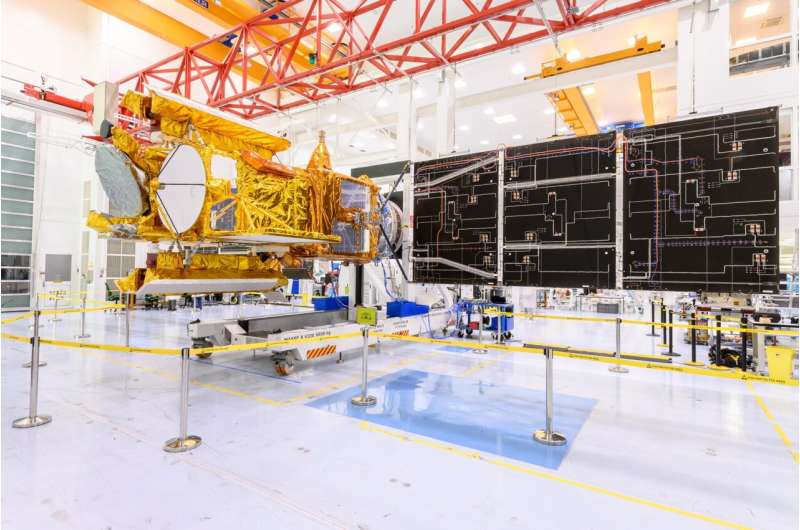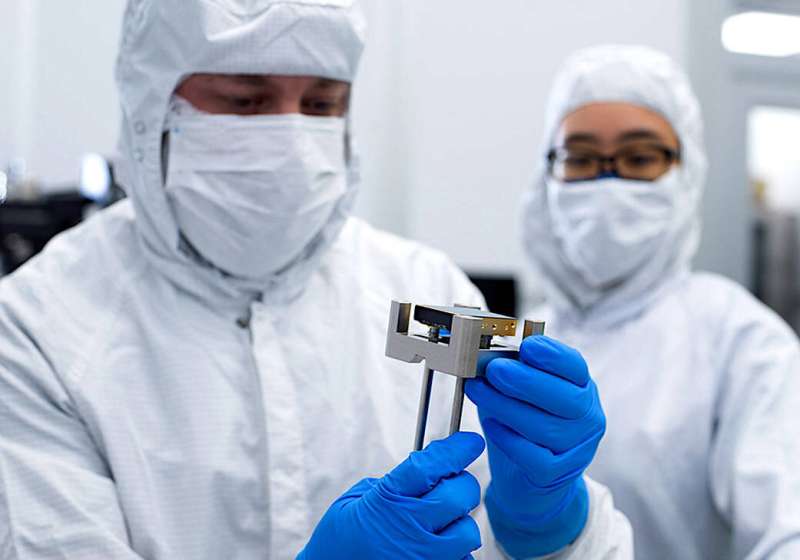
Copernical Team
AE Industrial Partners makes significant investment in York Space Systems
 AE Industrial Partners, LP ("AEI"), a leader in space investing and a private equity firm specializing in aerospace, defense and government services, space, power and utility services, and specialty industrial markets, announced that it has agreed to acquire a majority stake in York Space Systems , an independent provider of small satellites, satellite components and turnkey mission operations.
AE Industrial Partners, LP ("AEI"), a leader in space investing and a private equity firm specializing in aerospace, defense and government services, space, power and utility services, and specialty industrial markets, announced that it has agreed to acquire a majority stake in York Space Systems , an independent provider of small satellites, satellite components and turnkey mission operations. Laughing gas in space could mean life
 Scientists at UC Riverside are suggesting something is missing from the typical roster of chemicals that astrobiologists use to search for life on planets around other stars - laughing gas.
Chemical compounds in a planet's atmosphere that could indicate life, called biosignatures, typically include gases found in abundance in Earth's atmosphere today.
"There's been a lot of thought p
Scientists at UC Riverside are suggesting something is missing from the typical roster of chemicals that astrobiologists use to search for life on planets around other stars - laughing gas.
Chemical compounds in a planet's atmosphere that could indicate life, called biosignatures, typically include gases found in abundance in Earth's atmosphere today.
"There's been a lot of thought p Curiosity targets Canaima bedrock for sampling: Sol 3612
 Over the weekend, Curiosity took compositional measurements of the "Canaima" bedrock target in order to determine if the target merits collecting drilled sample. Concurrently, the engineering team took preload measurements to determine the stability of the rock for drilling. This morning the science and engineering teams reviewed the information downlinked and were excited to approve moving forw
Over the weekend, Curiosity took compositional measurements of the "Canaima" bedrock target in order to determine if the target merits collecting drilled sample. Concurrently, the engineering team took preload measurements to determine the stability of the rock for drilling. This morning the science and engineering teams reviewed the information downlinked and were excited to approve moving forw SOAR Telescope catches Dimorphos's expanding comet-like tail after DART impact
 NASA's Double Asteroid Redirection Test (DART) spacecraft intentionally crashed into Dimorphos, the asteroid moonlet in the double-asteroid system of Didymos, on Monday 26 September 2022. This was the first planetary defense test in which an impact of a spacecraft attempted to modify the orbit of an asteroid.
Two days after DART's impact, astronomers Teddy Kareta (Lowell Observatory) and M
NASA's Double Asteroid Redirection Test (DART) spacecraft intentionally crashed into Dimorphos, the asteroid moonlet in the double-asteroid system of Didymos, on Monday 26 September 2022. This was the first planetary defense test in which an impact of a spacecraft attempted to modify the orbit of an asteroid.
Two days after DART's impact, astronomers Teddy Kareta (Lowell Observatory) and M Firefly Aerospace reaches orbit and deploys customer payloads with its Alpha Rocket
 Firefly Aerospace, a new space leader in launch, spacecraft, and in-space services, announced that its Alpha FLTA002 mission successfully reached orbit and deployed customer payloads, lifting off on October 1 at 12:01am PST from Vandenberg Space Force Base in California.
With the success of this mission, Firefly is now the first company to launch and reach orbit from US soil in only its s
Firefly Aerospace, a new space leader in launch, spacecraft, and in-space services, announced that its Alpha FLTA002 mission successfully reached orbit and deployed customer payloads, lifting off on October 1 at 12:01am PST from Vandenberg Space Force Base in California.
With the success of this mission, Firefly is now the first company to launch and reach orbit from US soil in only its s SpaceX Crew 5 mission set to lift off for International Space Station
 NASA and Space X's Crew 5 mission is set to blast off for the International Space Station on Wednesday.
Hurricane Ian previously delayed the Crew 5 mission, along with the launch of the Artemis 1 moon test flight, but the Crew 5 launch is set for noon EDT.
The crew of four, which includes the first female commander and first Russian cosmonaut to fly on a SpaceX mission, arrived a
NASA and Space X's Crew 5 mission is set to blast off for the International Space Station on Wednesday.
Hurricane Ian previously delayed the Crew 5 mission, along with the launch of the Artemis 1 moon test flight, but the Crew 5 launch is set for noon EDT.
The crew of four, which includes the first female commander and first Russian cosmonaut to fly on a SpaceX mission, arrived a SpinLaunch completes Flight Test 10
 SpinLaunch has announced the results of its tenth successful Flight Test of its Suborbital Accelerator from Spaceport America, New Mexico. The flight test, which occurred on September 27, 2022, demonstrated that SpinLaunch partners' standard satellite components are inherently compatible with the company's launch environment, and provided critical flight data, as all payloads were flown and reco
SpinLaunch has announced the results of its tenth successful Flight Test of its Suborbital Accelerator from Spaceport America, New Mexico. The flight test, which occurred on September 27, 2022, demonstrated that SpinLaunch partners' standard satellite components are inherently compatible with the company's launch environment, and provided critical flight data, as all payloads were flown and reco Foreign object debris seen during Mars Ingenuity helicopter's 33rd flight (Video)
Use this form if you have come across a typo, inaccuracy or would like to send an edit request for the content on this page. For general inquiries, please use our contact form. For general feedback, use the public comments section below (please adhere to guidelines).
Please select the most appropriate category to facilitate processing of your request
Testing: Space-bound US-European water mission passes finals

Before any NASA mission is launched, the spacecraft goes through weeks of harsh treatment. It's strapped to a big table that shakes as hard as the pounding of a rocket launch. It's bombarded with louder noise than a stadium rock concert. It's frozen, baked, and irradiated in a vacuum chamber that simulates the extremes of space. The Surface Water and Ocean Topography mission (SWOT), a collaborative U.S.-French mission to monitor all the water on Earth's surface, has passed these major tests. Now, except for a few final checks, SWOT is ready for its December launch.
Some of SWOT's engineers at NASA's Jet Propulsion Laboratory in Southern California have invested almost a decade in designing, building, and assembling this complex mission. Watching the instruments they've labored over go through the latest round of tests has been stressful, but the team has taken the process in stride.
NASA's Roman mission delivers detectors to Japan's PRIME Telescope

Billy Keim, a NASA technician, removes a 16-megapixel detector from its shipping container internal fixture as engineer Stephanie Cheung coordinates the activity. NASA's future Nancy Grace Roman Space Telescope will be fitted with 18 of these infrared detectors, which have now been flight-approved.
The Roman team possesses extra detectors that will be used for other purposes. The team reserved six of the surplus detectors to serve as flight-quality backups and several more for testing. Additional spare detectors may serve as the eyes of other telescopes with more lenient quality requirements.
Roman has delivered four detectors to be used in the 64-megapixel camera in Japan's Prime-focus Infrared Microlensing Experiment (PRIME) telescope, located in the South African Astronomical Observatory in Sutherland. The detectors are contributed as part of an international agreement between NASA and the Japan Aerospace Exploration Agency (JAXA).
This telescope, which will be commissioned this fall, will hunt for exoplanets—worlds beyond our solar system—using the microlensing method. Roman scientists will use the results of this precursor survey to inform their observing strategy, maximizing the number of planets the mission will find.

